452 Search Results for visual supports
November 1, 2018
by Carole Zangari -

Today, Tabi Jones-Wohleber shares the last module in the MASTER PAL training series, which provides tips and strategies for working with children who don’t yet demonstrate joint attention. This module should take 30-40 minutes to present. Join us next week as we do a final wrap-up with suggestions on using this training series in your AAC work. ::::::::::::::::::::::::::::::::::::::::::::::::::::::::::::::::::::::::::::::::::::::::::::::::::::::::::::::: Model as a MASTER PAL Module 11: Let the Child Lead Facilitator Guidelines It can be really difficult to get communication started with a child who does not demonstrate joint attention. This module explores tips and strategies for traveling with a child on their journey from preoccupation with seeking sensory input/inattention to learning, engaging, and communicating. Because learning emerges from meaningful social emotional experiences, letting the child lead can go a long way toward being invited into their world. Then learning can happen! Here are some things you will need for this... [Read More...]
October 11, 2018
by Carole Zangari -
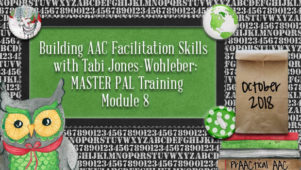
Our AAC Training Series continues today and we remain extremely appreciative that West Virginia based SLP Tabi Jones-Wohleber allows us to share these presentation materials. Today’s training materials center on a topic that will help AAC interventionists strengthen their relationships with AAC learners and provide important language learning opportunities at the same time. This module, Response NOT Required, is all about interactions that engage our learners and invite them into the conversation. The instructional time for Module 8 is about 20 minutes so this can feasibly be shared in a formal or informal sharing session before or after the school day. ::::::::::::::::::::::::::::::::::::::::::::::::::::::::::::::::::::::::::::::::::::::::::::::::::::::::::::: Model as a MASTER PAL Module 8: Response NOT Required Facilitator Guidelines When I talk about modeling without expectation of a response, I often get quizzical sideways glances. It is not an intuitive way of interacting, especially in an educational environment where responding is inherent in classroom... [Read More...]
August 30, 2018
by Carole Zangari -
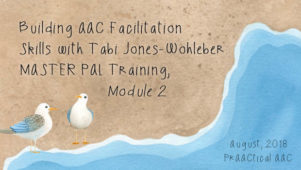
It’s a good day to talk training and we’re incredibly grateful to SLP Tabi Jones-Wohleber for sharing her partner training resources with us. In addition to her work with the AT Team for Frederick County Public Schools in Maryland, Tabi serves young children and their families at West Virginia Birth to Three programs. In the initial post, Tabi introduced the overview module and its accompanying resources. Today, we move onto Module 2 where the focus is on aided language input. ::::::::::::::::::::::::::::::::::::::::::::::::::::::::::::::::::::::::::::::::::::::::::::::::::::::::: Modeling AAC is unquestionably a key component of teaching AAC. Most frequenters of PrAACtical AAC understand that modeling is a naturalistic strategy that functions to support language development by SPEAKING YOUR WORDS. However, misconceptions abound, which often results in modeling opportunities characterized as imitation or compliance tasks. This module unpacks the imperative of modeling to provide a common understanding of what it is (and is not), and why it is a... [Read More...]
July 30, 2018
by Carole Zangari -
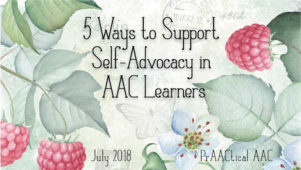
self-ad·vo·ca·cy: self ˈadvəkəsē/ Noun: the action of representing oneself or one’s views or interests. —————————- Empowering AAC learners to advocate for themselves may be one of the most important and impactful things that we can do to help them stay safe and achieve their goals. Here are some ways we can support that process. Provide messages for self-advocacy behaviors: It’s hard to represent your own interests without the appropriate set of vocabulary and messages. Words and prestored messages for protesting and rejecting are essential (e.g., No; Stop; No, thank you; I don’t want to). In addition, consider adding messages which allow the communicator to express disagreement or negative opinions (e.g., I don’t like it; I don’t think so; That doesn’t work for me; This is unfair; That’s disrespectful) and proactively provide self-advocacy information (e.g., Please do what I asked; It’s on my IEP; I have a right to be heard; I... [Read More...]
June 11, 2018
by Carole Zangari -
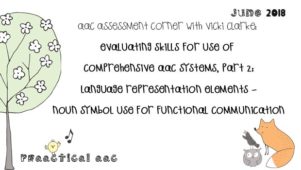
Vicki Clarke, CEO of Dynamic Therapy Associates and Director of DTA Schools, is back with another wonderful edition of AAC Assessment Corner. In addition to their clinic, Vicki and her team support school districts in AAC evaluation, equipment procurement, and implementation for individual students in the academic environment. DTA Schools also supports district-wide AAC implementation through the Classroom Communication Goals Project, training, and supporting all team members in classroom AAC implementation. In today’s post, Vicki shares her thoughts on how we can look at the use of AAC symbols for nouns as part of our evaluations for comprehensive AAC systems. You can view her previous contributions to the AAC Assessment Corner here. :::::::::::::::::::::::::::::::::::::::::::::::::::::::::::::::::::::::: Evaluating Skills For Use of Comprehensive AAC Systems, Part 2: Language Representation Elements – Noun Symbol Use for Functional Communication It was a crazy, busy month full of evaluations, trainings, and report writing. I’ve spent a lot of time with... [Read More...]
May 3, 2018
by Carole Zangari -
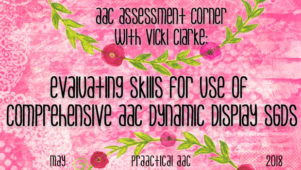
We’re always thrilled to share a guest post on AAC assessment practices from Vicki Clarke of Dynamic Therapy Associates. If you have questions about conducting AAC evaluations, read on. You can view her previous contributions to the AAC Assessment Corner here. :::::::::::::::::::::::::::::::::::::::::::::::::::::::::::::::::::::::::::::::::::: Evaluating Skills for Use of Comprehensive AAC Dynamic Display Systems Part I: Early Skills Over the past few years there has been an on-going discussion in the speech language pathology world about whether or not we needed to designate an official “specialty” recognition for augmentative and alternative communication practitioners. The argument goes something like this: It takes a lot of extra training, concerted effort in continuing education and daily practice in the assessment and implementation of augmentative communication to do it well. Therefore, we should have a “specialty area” in our national organization, ASHA, devoted to AAC. The counter-argument states that if our governing body says you need to... [Read More...]
October 19, 2017
by Carole Zangari -
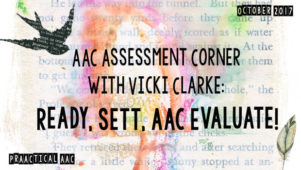
She’s bAACk! We couldn’t be happier to have another guest post on AAC assessment practices from Vicki Clarke of Dynamic Therapy Associates. In today’s post, she shares her tips and experiences for applying the SETT Framework to AAC assessment. If you are looking for information about how AACtual SLPs conduct their evaluations, Vicki’s posts are just what you need. You can view her previous contributions to the AAC Assessment Corner here. :::::::::::::::::::::::::::::::::::::::::::::::::::::::::::::::::::::::::::::::::::: Ready, SETT, AAC Evaluate! Last week I had the pleasure of joining the AAC After Work online conference hosted by Yapp Guru University. Jenna Coyer and I presented a session chatting about AAC assessment in emergent communicators. As we have worked to define our process for evaluation, we found ourselves repeatedly returning to the same approach our Assistive Technology teams use—the SETT Framework. The SETT Framework was developed by Joy Zabala as a process for making decisions about... [Read More...]
May 4, 2017
by Carole Zangari -
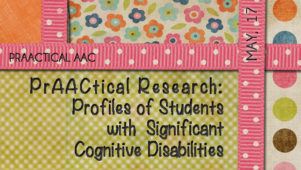
In today’s post, we welcome Dr. Kathy Howery who will be appearing here periodically to review some of the AAC research that is published in journals around the world. Kathy joins us from Alberta, Canada, and has worked in the field of assistive technology and special education for over three decades. Most recently she has completed her doctoral studies where she used phenomenological methods to seek understanding of the lived experience of speaking with/through a speech generating device. Kathy is currently working as consultant to schools and school districts across Alberta focusing primarily on children and youth with complex communication needs. In this first post, she helps us understand a study by Drs. Karen Erickson and Lori Geist published in the AAC journal last year. Enjoy! ::::::::::::::::::::::::::::::::::::::::::::::::::::::::::::::::::::::::::::::: Erickson, K. A. & Geist, L. A. (2016). The profiles of students with significant cognitive disabilities and complex communication needs. Augmentative and Alternative Communication,... [Read More...]
June 28, 2016
by Carole Zangari -
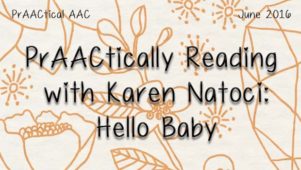
Karen Natoci is back with some wonderful suggestions for reading and building AAC skills with young children. Although her focus is on little ones with visual impairment, these books and the implementation suggestions, would be useful for a wide range babies, toddlers, and preschoolers who are developing their language skills. Enjoy! :::::::::::::::::::::::::::::::::::::::::::::: Books Hello Baby Words (high contrast board books) by Roger Priddy, illustrated by Holly Jackman (Published by St. Martin’s Press, 175 Fifth Avenue, NY 10010) Hello Baby Words: On The Go Hello Baby Words: Faces Hello Baby: Animals Hello Baby: Faces Core Vocabulary Focus: GO, GET, WHO, THAT, SEE, IT Fringe Vocabulary Transportation: digger, balloon, train, roller skates, helicopter, truck, car, submarine, rocket, dump truck, fire truck, boat, race car, tractor, car carrier, plane Animals: cat, turtle, fish, pig, butterfly, cow, mouse, bird, bear, zebra, rabbit, panda, penguin, dog, sheep, snake Faces: boy, girl, woman, man, grandfather, grandmother... [Read More...]
March 2, 2016
by Carole Zangari -
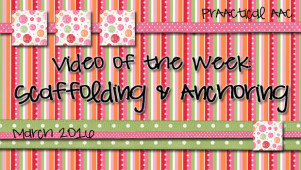
In this week’s video, we feature SLP Shannon Hennig who talks to us about some of her strategies for teaching language learners. As with her previous video, Shannon’s suggestions are clear, relevant, and prAACtical. Enjoy!









